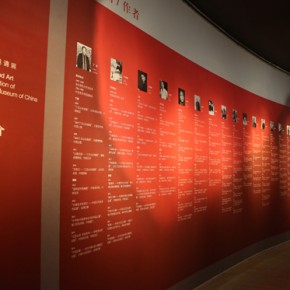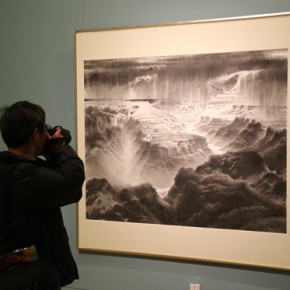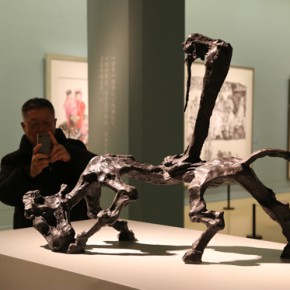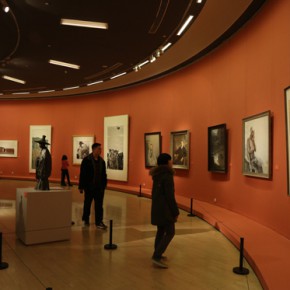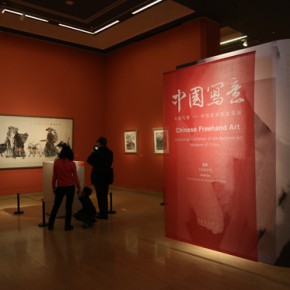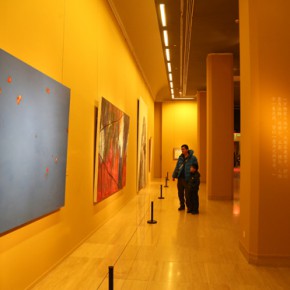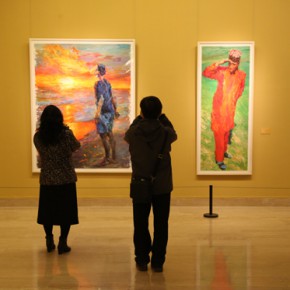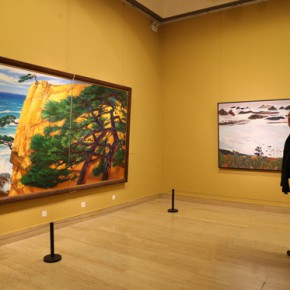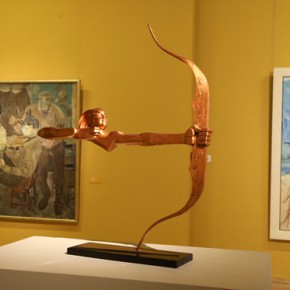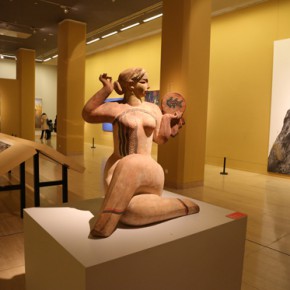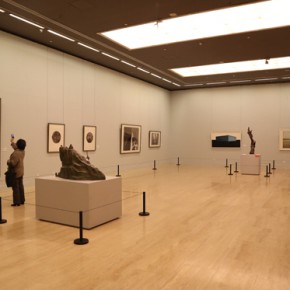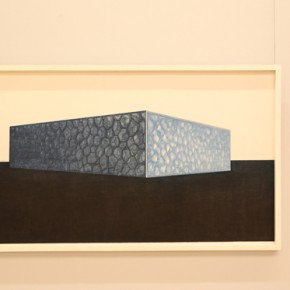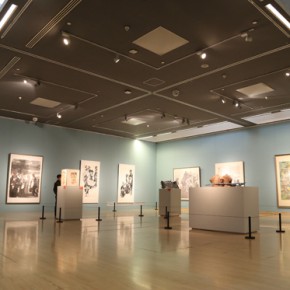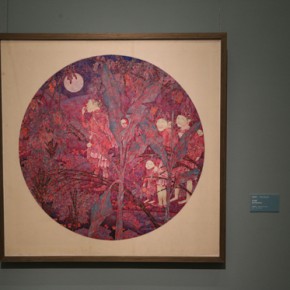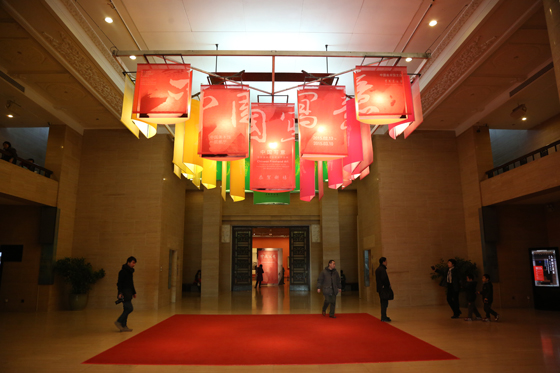
On February 13, on the occasion of the Chinese New Year, “Promoting the Chinese Spirit” exhibition series “Chinese Freehand Art – Invitational Exhibition of the National Art Museum of China” opened at the National Art Museum of China. It will continue to March 10.
The Power of Chinese Freehand Art – On Chinese Freehand ArtFreehand is the spirit of Chinese art.
When the freehand form of oil painting is used in a vision, it is different from the inert knowledge of Chinese people to Western oil painting. In fact the spirit of freehand itself naturally has an openness and inclusiveness, not only offering a possibility for the combination of Chinese and foreign art, but also integrating the ancient and the present in reality. The imported oil paintings did not only bring new possibilities to Chinese art in the development process of over 100 years, but also highlights its value in the connection, dialogue and common development between Chinese traditional culture and the world, to realize a comparison with “heterogeneous isomorphism”, “homogeneous assimilation”. Among this, the hazy and moving colors and lights corresponds with the impressionism depicted as confused and ignorant inky art of the landscape paintings of Mi’s family. Since the 20th century some painters have achieved remarkable achievements in this aspect, which are examples of “homogeneous assimilation”. Therefore, the freehand characteristics of Chinese oil painting is not only the embodiment of the originality of oil painting, but also the crystallization of the collision, intercourse, separation, and direction between the Chinese and Western cultures incorporating a view of nature, historical view, value judgment and aesthetic ideal, which is the representation of the Chinese freehand spirit connected with the ontology of Western oil painting at the level of thinking and expression. In addition, freehand oil painting also absorbs the construction of life essence from Western expressionism including the native freehand cultural quality which also becomes the model of westernized Chinese style.
In the developing process of thousands of years, the traditional Chinese sculpture gradually formed a freehand tradition and style, which is different from the traditional Western realism sculpture with its unique aesthetic form. Different from the Western idea that is centered on “man”, traditional Chinese sculpture reflects the Chinese culture that is in pursuit of the “unity of heaven and man, respecting the imperial power and the theocracy, laying particular stress on the shaping of mental imagery. In ancient times, Chinese sculpture highlights the creative focus on spirituality: the simple and clumsy imagery of the original period, the weird and charming abstract in the Shang Dynasty, the adornment and realism in the Qin Dynasty, the forceful and freehand as adopted during the West and East Han Dynasties, the worldly emotions in the Song Dynasty, as well as the ideal Buddhist shapes, the exaggerated program of imperial mausoleum and simple folk performance, numerous astonishing classics jointly build the ecologic garden of traditional Chinese freehand sculptures. However, since the May 4th Movement, along with the introduction of Western value system and the epistemological basis of plastic arts, traditional sculpture was heavily eroded and was excluded from the mainstream, which caused multiple faults with the native sculptures in China from the spirit to the style. After the founding of new China, the art teaching mode of the Soviet Union was introduced to various art colleges and universities, so the development of Chinese sculpture mainly depended on the promotion of external factors until the 1980s. Sculptors and theorists have to be congratulated as they came to realize that there is a certain gap between mainstream sculpture and traditional sculpture, and began to consciously reflect on traditional sculpture. They penetrated into the ontology of sculptural art, to grasp the rules of shaping and aesthetic spirit, making innovative work that inspired the modern transformation of Chinese traditional sculpture. Now, a large number of sculptors have used the freehand spirit as the form to activate the traditional and to consciously practice it. They do not only absorb the nutrients from the traditional culture and art, but also learn shape, anatomy, perspective from Western realist sculptures and feel the humanism that has been penetrated into the works – from the stillness and simplicity of the ancient Greek to the profound performance of humans that have been showcased in Rodin’s sculptures, to constantly enrich and strengthen the shaping ability and representation. Especially the understanding of Chinese traditional humanistic spirit which is promoted as significant for the survival theory, which showcases the binary opposition of the present and what is absent from the world of the mind, to create a new world for contemporary Chinese sculpture of the times. In addition, the sculptors also learned the form and structure from the modernism of art work, awareness of the shaping in the body, lines, and surfaces.
Print is also an important category of fine arts, its unique feel of the knife and wood has become an important part of Chinese art context. Ancient print mainly refers to woodblocks, in addition to a few copper engravings and chromatography prints. Lu Xun advocated new woodblock printmaking in the 1930s, opening up a new era for the creation of print. Compared with the ancient print, the burgeoning print is not only different in the technology of production, but also has a qualitative difference in the function of art and a realistic sense. Since the reform and opening up, along with the increasing value of foreign exchange, the theme, form and artistic language is increasingly rich, with various expressive techniques being constantly tried, to break through the performance model that takes realism as the only way, thus emerged a large number of outstanding works created through the use of many expressive means such as exaggeration, deformaty, symbol, implication. In addition, the wide application of new tool material expands the scope of styles of printmaking: lithography, copper etching, screen printing plate, plaster print and other integrated prints appeared in succession. Of course, it is a challenge on how to inherit the traditional while reflecting the contemporary nature of art in the language of printed art, the contemporary nature of print does not only focus on the contemporary nature of formal language, but the key point is the contemporary nature of spiritual implication. The creation of the Chinese contemporary printmaking represents the trend of returning to tradition and ontology, in the traditional engravings, woodblock New Year pictures, discovering the elements of formal beauty in the aesthetic norms that take ink and wash as the main media, and then finding matching images and abstract works within the achievement of a visual art revolution during the 20th century. Through the freehand language of the prints, it is like a poem it expands to a new horizon. Through diverse techniques and patterns, the vivid artistic conception of freehand spirit is presented, and it is possible to find “minimalist”, “surreal”, it is possible to find watermark, silk screen, cutter, and even modern imageries after combining concepts and techniques in digital art. It presents a lot of work which we can see as the hope for printmaking in the future.
Wu Weishan
Director of the National Art Museum of China
February 3, 2015
Abstracted from the preface of “Chinese Freehand Art – Invitational Exhibition of the National Art Museum of China”, translated by Chen Peihua and edited by Sue/CAFA ART INFO


